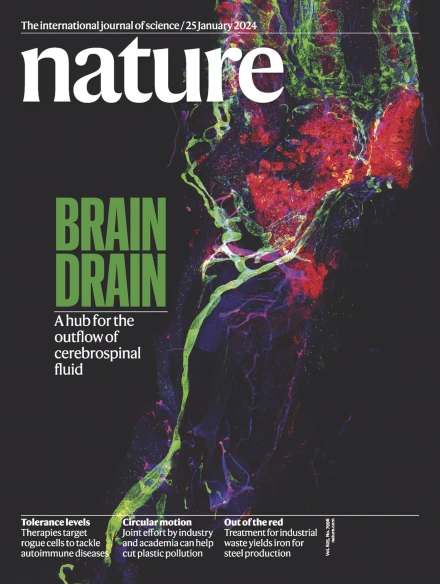Nanobody therapy rescues behavioural deficits of NMDA receptor hypofunction
IF 48.5
1区 综合性期刊
Q1 MULTIDISCIPLINARY SCIENCES
引用次数: 0
Abstract
There is an urgent need for efficient and innovative therapies to treat brain disorders such as psychiatric and neurodegenerative diseases. Immunotherapies have proved to be efficient in many medical areas, but have not been considered to treat brain diseases due to the poor brain penetration of immunoglobulins1,2. Here we developed a bivalent biparatopic antibody, made of two camelid heavy-chain antibodies (called nanobodies)3, one binding to, and the other potentiating the activity of, homodimeric metabotropic glutamate receptor 2. We show that this bivalent nanobody, given peripherally, reaches the brain and corrects cognitive deficits in two preclinical mouse models with endophenotypes resulting from NMDA receptor hypofunction. Notably, these in vivo effects last for at least 7 days after a single intraperitoneal injection and are maintained after subchronic treatment. Our results establish a proof of concept that nanobodies can target brain receptors, and pave the way for nanobody-based therapeutic strategies for the treatment of brain disorders. A bivalent biparatopic nanobody penetrates the brain, binds to and potentiates the activity of homodimeric metabotropic glutamate receptor 2, correcting cognitive deficits in two preclinical mouse models with endophenotypes resulting from NMDA receptor hypofunction.

纳米体治疗挽救NMDA受体功能低下的行为缺陷。
迫切需要有效和创新的治疗方法来治疗脑部疾病,如精神和神经退行性疾病。免疫疗法在许多医学领域已被证明是有效的,但由于免疫球蛋白的脑渗透能力差,尚未被认为可以治疗脑部疾病1,2。在这里,我们开发了一种二价双异位抗体,由两个骆驼重链抗体(称为纳米体)3组成,一个与同二聚体代谢性谷氨酸受体2结合,另一个增强其活性。我们发现,在两种由NMDA受体功能低下引起的内表型的临床前小鼠模型中,这种外周给予的二价纳米体可以到达大脑并纠正认知缺陷。值得注意的是,这些体内效应在单次腹腔注射后至少持续7天,并在亚慢性治疗后保持。我们的研究结果证明了纳米体可以靶向大脑受体的概念,并为基于纳米体的治疗脑部疾病的治疗策略铺平了道路。
本文章由计算机程序翻译,如有差异,请以英文原文为准。
求助全文
约1分钟内获得全文
求助全文
来源期刊

Nature
综合性期刊-综合性期刊
CiteScore
90.00
自引率
1.20%
发文量
3652
审稿时长
3 months
期刊介绍:
Nature is a prestigious international journal that publishes peer-reviewed research in various scientific and technological fields. The selection of articles is based on criteria such as originality, importance, interdisciplinary relevance, timeliness, accessibility, elegance, and surprising conclusions. In addition to showcasing significant scientific advances, Nature delivers rapid, authoritative, insightful news, and interpretation of current and upcoming trends impacting science, scientists, and the broader public. The journal serves a dual purpose: firstly, to promptly share noteworthy scientific advances and foster discussions among scientists, and secondly, to ensure the swift dissemination of scientific results globally, emphasizing their significance for knowledge, culture, and daily life.
 求助内容:
求助内容: 应助结果提醒方式:
应助结果提醒方式:


